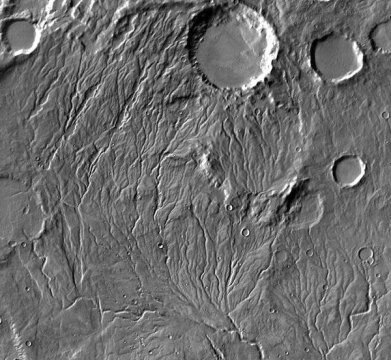For scientists trying to understand what ancient Mars might have been like, the red planet sends some mixed signals. Water-carved valleys and lakebeds leave little doubt that water once flowed on the surface. But climate models for early Mars suggest average temperatures around the globe stayed well below freezing.
A recent study led by geologists offers a potential bridge between the “warm and wet” story told by Martian geology and the “cold and icy” past suggested by atmospheric models. The study shows that it’s plausible, even if Mars was generally frozen over, that peak daily temperatures in summer might sneak above freezing just enough to cause melting at the edges of glaciers. That meltwater, produced in relatively small amounts year after year, could have been enough to carve the features observed on the planet today, the researchers conclude according to Science daily.
“We see this in the Antarctic Dry Valleys, where seasonal temperature variation is sufficient to form and sustain lakes even though mean annual temperature is well below freezing,” Palumbo said. “We wanted to see if something similar might be possible for ancient Mars.”
The researchers started with a state-of-the-art climate model for Mars — one that assumes an ancient atmosphere composed largely of carbon dioxide (as it is today). The model generally produces a cold and icy early Mars, partly because the sun’s energy output is thought to have been much weaker early in solar system history. The researchers ran the model for a broad parameter space for variables that may have been important around 4 billion years ago when the iconic valley networks on the planet’s southern highlands were formed.
While scientists generally agree that the Martian atmosphere was thicker in the past, it’s not clear just how thick it actually was. Likewise, while most researchers agree that the atmosphere was mostly carbon dioxide, there may have been small amounts of other greenhouse gases present. So Palumbo and her colleagues ran the model with various plausible atmospheric thicknesses and extra amounts of greenhouse warming.
It’s also not known exactly what the variations in Mars’ orbit might have been like 4 billion years ago, so the researchers tested a range of plausible orbital scenarios. They tested different degrees of axis tilt, which influences how much sunlight the planet’s upper and lower latitudes receive, as well as different degrees of eccentricity — the extent to which the planet’s orbit around the sun deviates from a circle, which can amplify seasonal temperature changes.
The model produced scenarios in which ice covered the region near the location of the valley networks. And while the planet’s mean annual temperature in those scenarios stayed well below freezing, the model produced peak summertime temperatures in the southern highlands that rose above freezing.
In order for this mechanism to possibly explain the valley networks, it must produce the correct volume of water in the time duration of valley network formation, and the water must run off on the surface at rates comparable to those required for valley network incision. A few years ago, Head and Eliot Rosenberg, an undergraduate at the time who has since graduated, published an estimate of the minimum amount of water required to carve the largest of the valleys. Using that as a guide, along with estimates of necessary runoff rates and the duration of valley network formation from other studies, Palumbo showed that model runs in which the Martian orbit was highly eccentric did indeed meet these criteria. That degree of eccentricity required is well within the range of possible orbits for Mars 4 billion years ago, Palumbo says.
Taken together, Palumbo says, the results offer a potential means of reconciling the geological evidence for flowing water on early Mars with the atmospheric evidence for a cold and icy planet.
“This work adds a plausible hypothesis to explain the way in which liquid water could have formed on early Mars, in a manner similar to the seasonal melting that produces the streams and lakes we observe during our field work in the Antarctic McMurdo Dry Valleys,” Head said. “We are currently exploring additional candidate warming mechanisms, including volcanism and impact cratering, that might also contribute to melting of a cold and icy early Mars.”
So while the work doesn’t close the “cold and icy” versus “warm and wet” debate, it does make the case that a mostly frozen early Mars was a distinct possibility.
N.H.Kh

